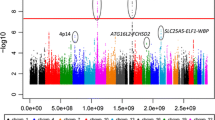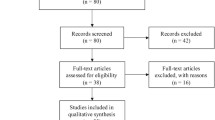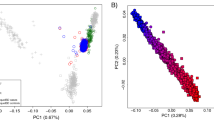Abstract
Purpose
Recent genome-wide association studies have identified a number of inflammatory bowel diseases (IBD) susceptibility loci in White populations. The aim of our study was to evaluate whether these susceptibility loci also existed in a Chinese Han IBD population.
Methods
Peripheral blood DNA samples from groups of patients with Crohn’s disease (CD) (n = 48), ulcerative colitis (UC) (n = 49), and healthy controls (n = 50) were genotyped for eight genes. Then, an extended analysis of the relationship between genotype and phenotype was performed.
Results
NOD2-P268S (P = 0.025) was found to contribute susceptibility to CD in the Chinese population. IL23R-rs11805303 was detected to confer a strong protective effect against UC (P = 0.010), whereas PTPN2-rs2542151 was significantly associated with an increased risk of UC (P = 0.001). Further phenotype–genotype analysis revealed that P268S was associated with early age of onset (P = 0.028), ileal disease (P = 0.003), and enteric cavity narrowing (P = 0.007).
Conclusions
The study indicates that IL23R-rs11805303 and PTPN2-rs2542151 might contribute to the development of UC and NOD2-P268S might be involved in the etiology of CD in the Chinese Han population.



Similar content being viewed by others
References
Xavier RJ, Podolsky DK (2007) Unravelling the pathogenesis of inflammatory bowel disease. Nature 448:427–434
Hirschhorn JN, Daly MJ (2005) Genome-wide association studies for common diseases and complex traits. Nat Rev Genet 6:95–108
Naderi N, Farnood A, Habibi M et al (2011) NOD2 exonic variations in Iranian Crohn’s disease patients. Int J Colorectal Dis 26:775–781
Duerr RH, Taylor KD, Brant SR et al (2006) A genome-wide association study identifies IL23R as an inflammatory bowel disease gene. Science 314:1461–1463
Ogura Y, Bonen DK, Inohara N et al (2001) A frameshift mutation in NOD2 associated with susceptibility to Crohn’s disease. Nature 411:603–606
Lamhonwah AM, Ackerley C, Onizuka R et al (2005) Epitope shared by functional variant of organic cation/carnitine transporter, OCTN1, Campylobacter jejuni and Mycobacterium paratuberculosis may underlie susceptibility to Crohn’s disease at 5q31. Biochem Biophys Res Commun 337:1165–1175
Lesage S, Zouali H, Cezard JP et al (2002) CARD15/NOD2 mutational analysis and genotype–phenotype correlation in 612 patients with inflammatory bowel disease. Am J Hum Genet 70:845–857
Okazaki T, Wang MH, Rawsthorne P et al (2008) Contributions of IBD5, IL23R, ATG16L1, NOD2 to Crohn’s disease risk in a population-based case–control study: evidence of gene–gene interactions. Inflamm Bowel Dis 14:1528–1541
Arnott ID, Nimmo ER, Drummond HE et al (2004) NOD2/CARD15, TLR4 and CD14 mutations in Scottish and Irish Crohn’s disease patients: evidence for genetic heterogeneity within Europe? Genes Immune 5:417–425
Chua KH, Hilmi I, Ng CC et al (2009) Identification of NOD2/CARD15 mutations in Malaysian patients with Crohn’s disease. J Dig Dis 10:124–130
Sugimura K, Taylor KD, Lin YC et al (2003) A novel NOD2/CARD15 haplotype conferring risk for Crohn disease in Ashkenazi Jews. Am J Hum Genet 72:509–518
Wellcome Trust Case Control Consortium (2007) Genome-wide association study of 14,000 cases of seven common diseases and 3,000 shared controls. Nature 447:661–678
Yang SK, Loftus EV, Sandborn WJ (2001) Epidemiology of inflammatory bowel disease in Asia. Inflamm Bowel Dis 7:260–270
Thia KT, Loftus EV, Sandborn WJ, Yang SK (2008) An update on the epidemiology of inflammatory bowel disease in Asia. Am J Gastroenterol 103:3167–3182
Leong RW, Armuzzi A, Ahmad T et al (2003) NOD2/CARD15 gene polymorphisms and Crohn’s disease in the Chinese population. Aliment Pharmacol Ther 17:1465–1470
Gasche C, Nemeth M, Grundtner P, Willheim-Polli C, Ferenci P, Schwarzenbacher R (2008) Evolution of Crohn’s disease-associated Nod2 mutations. Immunogenetics 60:115–120
Juyal G, Amre D, Midha V, Sood A, Seidman E, Thelma BK (2007) Evidence of allelic heterogeneity for associations between the NOD2/CARD15 gene and ulcerative colitis among North Indians. Aliment Pharmacol Ther 26:1325–1332
Leshinsky-Silver E, Karban A, Buzhakor E et al (2005) Is age of onset of Crohn’s disease governed by mutations in NOD2/caspase recruitment domains 15 and Toll-like receptor 4? Evaluation of a pediatric cohort. Pediatr Res 58:499–504
Abreu MT, Taylor KD, Lin YC et al (2002) Mutations in NOD2 are associated with fibrostenosing disease in patients with Crohn’s disease. Gastroenterology 123:679–688
Bonen DK, Ogura Y, Nicolae DL et al (2003) Crohn’s disease-associated NOD2 variants share a signaling defect in response to lipopolysaccharide and peptidoglycan. Gastroenterology 124:140–146
Sans M, Castells A (2008) Ulcerative colitis and Crohn’s disease genetics: more similar than we thought? Gastroenterology 135:1796–1798
Umeno J, Asano K, Matsushita T et al (2011) Meta-analysis of published studies identified eight additional common susceptibility loci for Crohn’s disease and ulcerative colitis. Inflamm Bowel Dis 17:2407–2415
Franke A, Balschun T, Karlsen TH et al (2008) Replication of signals from recent studies of Crohn’s disease identifies previously unknown disease loci for ulcerative colitis. Nat Genet 40:713–715
Morgan AR, Han DY, Huebner C, Lam WJ, Fraser AG, Ferguson LR (2010) PTPN2 but not PTPN22 is associated with Crohn’s disease in a New Zealand population. Tissue Antigens 76:119–125
Yamazaki K, Takahashi A, Takazoe M et al (2009) Positive association of genetic variants in the upstream region of NKX2-3 with Crohn’s disease in Japanese patients. Gut 58:228–232
Yamazaki K, Onouchi Y, Takazoe M, Kubo M, Nakamura Y, Hata A (2007) Association analysis of genetic variants in IL23R, ATG16L1 and 5p13.1 loci with Crohn’s disease in Japanese patients. J Hum Genet 52:575–583
Yang SK, Jung Y, Hong M et al (2011) No association between TNFSF15 and IL23R with ulcerative colitis in Koreans. J Hum Genet 56:200–204
Heide F, Nolte IM, Kleibeuker JH, Wijmenga C, Dijkstra G, Weersma RK (2010) Differences in genetic background between active smokers, passive smokers, and non-smokers with Crohn’s disease. Am J Gastroenterol 105:1165–1172
Mankertz J, Schulzke D (2007) Altered permeability in inflammatory bowel disease: pathophysiology and clinical implications. Curr Opin Gastroenterol 23:379–383
Acknowledgments
We thank the Guangdong Provincial Science and Technology Foundation for the grant support to Fachao Zhi.
Author information
Authors and Affiliations
Corresponding author
Additional information
Chaolan Lv and Xiaoming Yang equally contributed to the work.
Rights and permissions
About this article
Cite this article
Lv, C., Yang, X., Zhang, Y. et al. Confirmation of three inflammatory bowel disease susceptibility loci in a Chinese cohort. Int J Colorectal Dis 27, 1465–1472 (2012). https://doi.org/10.1007/s00384-012-1450-6
Accepted:
Published:
Issue Date:
DOI: https://doi.org/10.1007/s00384-012-1450-6




